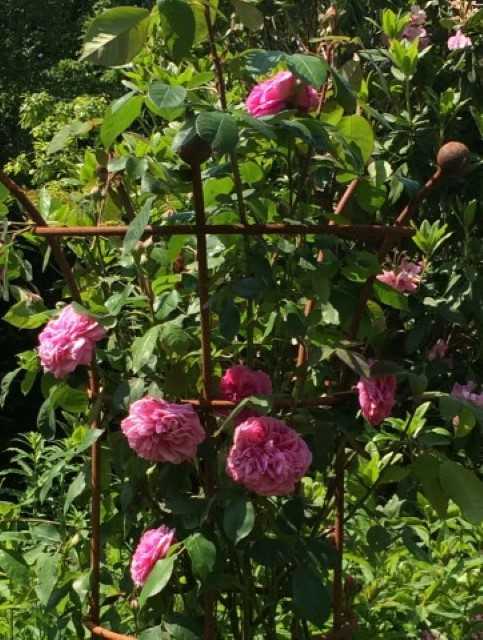
How to train your shrubs and climbers
Lesley Ann Sandbach
Rosa ‘Gertrude Jekyll’, a favourite of many gardeners, spills out of the top of a clematis and rose obelisk.

Roses and clematis grow luxuriantly on a circular obelisk in designer Barbara Brooks’ garden.
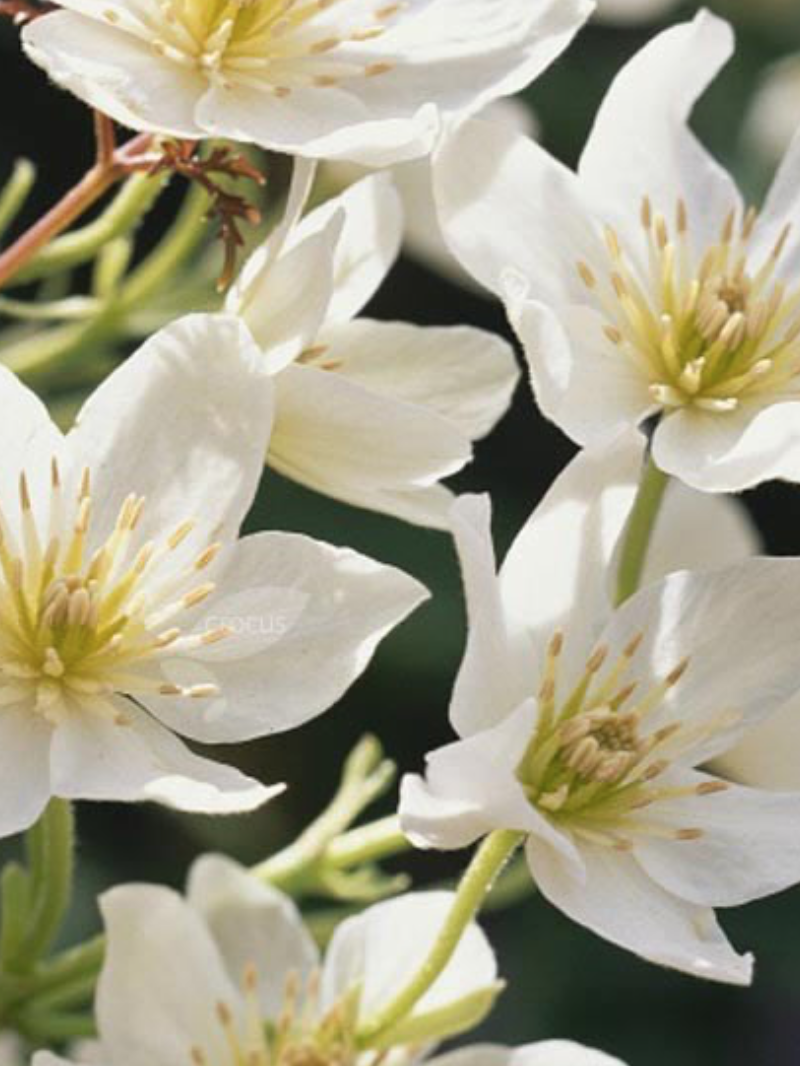
Clematis ‘Early Splendour’ is a charming early flower.
Why is Winter the right time of year to think about climbing plants?
As the cold and the winds (particularly here in Gloucestershire) strip the leaves off our climbers, their bare structure emerges and now is the time to stand back and take a good, hard look at what we’ve managed to ignore all summer when they were full of leaf and flower.
Climbing plants that need support include popular perennials such as: roses, wisteria, clematis and the jasmines, including trachelospermum jasminoides (the star jasmine). All too often, the weight of the climber is hanging off the wall or the rose has gone straight to the top of its support and is flowering well above our heads.
Roses and wisteria
To ensure you achieve the healthiest and best-shaped plants, which in turn will give you the best flowers, you need to prune annually. This is normally done in early spring for roses (to ensure the rose does not put on early growth that can be hit by late frosts) and twice a year for wisterias but, in our milder, wetter climate a little shaping to a support in November will do no harm.
The aim of pruning is to encourage the plants to produce lots of flower buds on a well-spaced framework of branches and both roses and wisterias will flower much better if their branches are trained horizontally.
For expert advice consult Ken Molinari of the New York Botanical Garden who gives detailed advice on every kind of climbing rose or Alan Titchmarsh in Country Life on wisterias.
You will need:
-
A pair of stout gloves – roses have thorns!
-
A good pair of secateurs and, possibly, long-handled loppers – I use Niwaki secateurs and was taught how to sharpen them by Jekka McVicar herself whom I met on the Niwaki stand!
-
String to tie in the branches.
Standard roses and wisteria – 150cm or 200cm umbrellas
Standard roses in bloom look wonderful until wind or rain bends the flower heads or, worse, breaks the branches. The Victorians and Edwardians loved standards and fabricated umbrellas out of intricate wirework. We have simplified the design and made the rose or wisteria, we hope, the star!
How to put in the umbrella:
-
Ideally this is done when the rose/wisteria is planted but it can be retro-fitted – with care!
-
Put the two parts of the umbrella together fastening the umbrella to the post with an Allen key
-
Hammer the post in (the ball on top can take the force of a lump hammer easily) as close to the stem as possible – there will be a little, but minimal, root damage – until the umbrella meets the head of the standard rose or the point at which the wisteria will be trained horizontally; the post should go into the ground between 30cm and 50cm to give stability – particularly for wisterias, which are very vigorous
-
Tie the stem to the post securely and then begin to tie in laterally any growth that appears above the ‘spokes’ of the umbrella
-
Carry on tying in growth on top of the umbrella as the season progresses and your roses will flower more and be more secure; for wisteria to be grown successfully as a standard, a rigorous pruning regime needs to be followed – see Anglian Gardener for specific advice.

… and in the summer clematis ‘The President’ reaches the top of the 2.5m obelisk!

A standard rose has just been put in and the young growth tie in on top of the ‘spokes’ of the umbrella.

A standard rose in its third season – the head is fully supported by a Muntons’ rose umbrella and flowering freely.
Climbers on obelisks
Roses, clematis, jasmines and obelisks were meant to be together but they too need to be trained to grow round, and not up, their supports. With clematis and jasmines, I just encourage their waving fronds inwards or round the support, tying in a few, but roses need a bit more help.
Left to themselves, climbing roses will do just that - climb! They need to be encouraged to grow round and up their supports and now, when the stems are bare, is a good time to help them along.
I have started to train my rosa ‘Tea Clipper’ (a lovely, buff David Austen rose) around the circular obelisk that I have planted it in...
Clematis
I plant one or two clematis with different flowering times with my roses. All of the blue and purple ones look beautiful with pink or white roses.
My favourites are: ‘The President’; ‘Etoile Violette’; ‘Jackmanii’ and for a stunning, early white: ‘Early Sensation’ - although a late Gloucestershire frost wiped out the flowers in 2019, the evergreen, ferny leaves are lovely.
Climbers on trellises - wisterias, roses, jasmines and honeysuckles
Traditionally, trellises have been wooden and screwed to the wall or on a hook and wire system. Inevitably, the wood rots over the years, the wires sag and, just when the rose or honeysuckle has reached the top, the support gives way.
We have developed a number of trellis designs that we hope will answer most of the problems of training plants upwards and outwards while still giving the plant room to breathe.
Which trellis suits my garden?
We supply either open or closed trellises for wall mounting; the trellises are supplied with stout ‘spacer’ brackets that allow space for the plant to grow between the wall and the trellis, making it easier to train.
If the wall or fence is not sufficiently strong to take the full weight of the trellis, we can supply it with legs that simply push into the ground and the trellis can be tied back to the wall with brackets to keep it vertical without putting any weight on it.
For more difficult places, such as a narrow wall, a fan trellis might be the answer or, for a support that can be fitted round a down-pipe, a clematis wall support is an attractive solution.
We do not recommend that trellises should be free-standing – the weight of plants offers strong resistance to wind and rain. If there is no suitable wall, consider an espalier-type support which has supporting legs behind the structure that can be Postcreted into the ground for support - either straight or curved, in single or multiple panels.
Our houses and gardens are not uniform in size or shape and, because we know you want what’s right for your garden, we are always happy to talk to you about bespoke sizes and what might work best for your particular situation. Many of our designs have been developed though a process of discussions with gardeners who have particular problems they want to solve.
Browse the complete range at www.muntons.net
Follow us on Pinterest for more advice and inspiration for your English country garden: www.pinterest.co.uk/plantsupports
Follow us on Instagram: www.instagram.com/muntons_plant_supports

June: Rosa ‘Tea Clipper’ reaches for the sky supported by a Muntons’ circular obelisk.
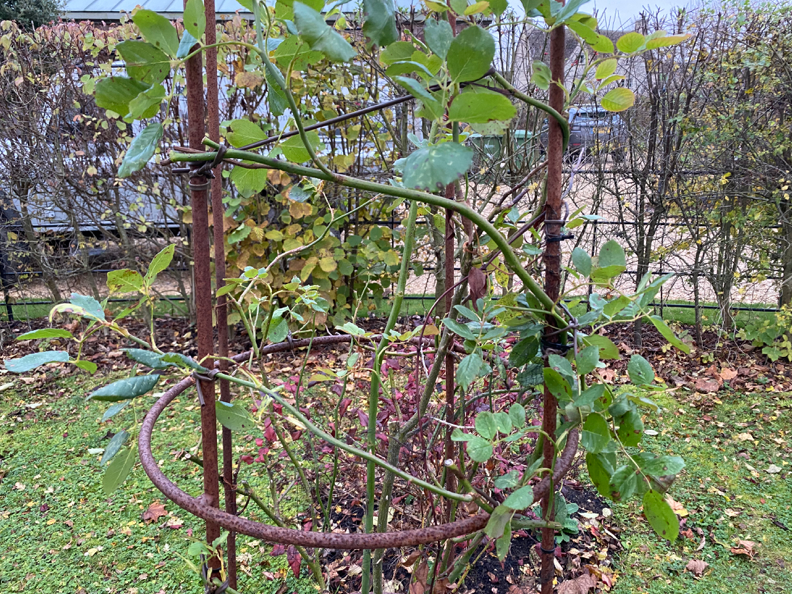
November: Training ‘Tea Clipper’ in an upward spiral around the outside of the circular obelisk.
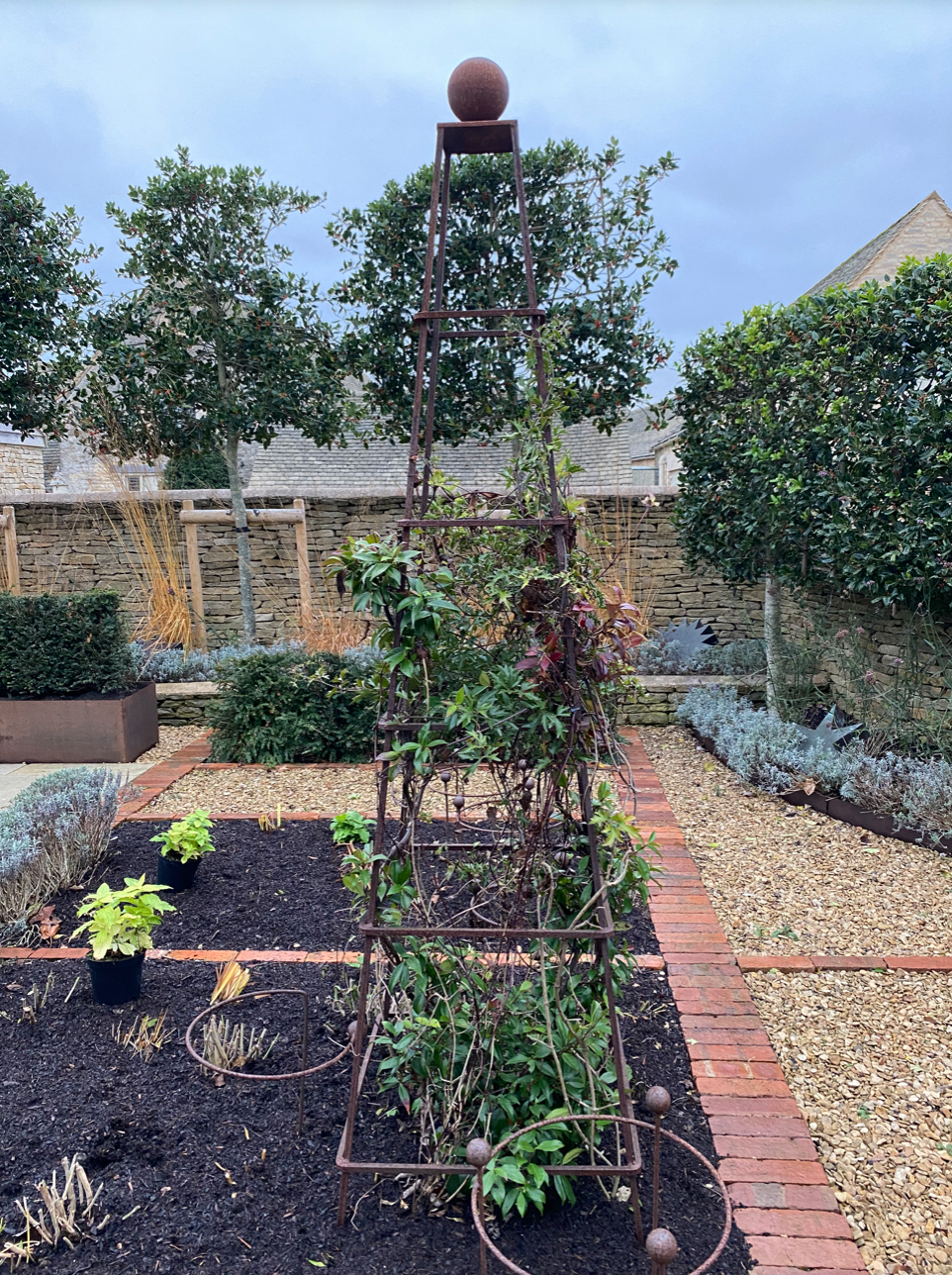
Even in the winter garden, an Abinger obelisk planted with trachelospermum jasminoides, clematis ‘The President’ and clematis ‘Early Splendour’ makes an architectural statement.
Commit to spending more time out of doors enjoying your garden.
We walk round the garden every morning with our first cup of tea and again at dusk. These are the times when we discuss what we have been doing and what needs to be tackled; pause to admire individual plants; breath in fresh air and relax after another day at work. It is a great space for entertaining friends and family; a safe place for children and pets; a haven for peace and contemplation – there is great solace in a garden – and a canvas for your own creativity.
You never know how it will inspire you: perhaps you will want to pick up a camera and photograph it; record it in a written or photographic diary; pick up a paintbrush and paint it or build on your new passion for learning about gardening by studying for an RHS diploma.
Whatever it is that gets you out there, make sure your plant supports aren’t the things that ruin the moment. Check out our range of stylish and sturdy supports that will be sure to wow.
Browse the complete range at www.muntons.net
Follow us on Pinterest for more advice and inspiration for your English country garden: www.pinterest.co.uk/plantsupports
Follow us on Instagram: www.instagram.com/muntons_plant_supports
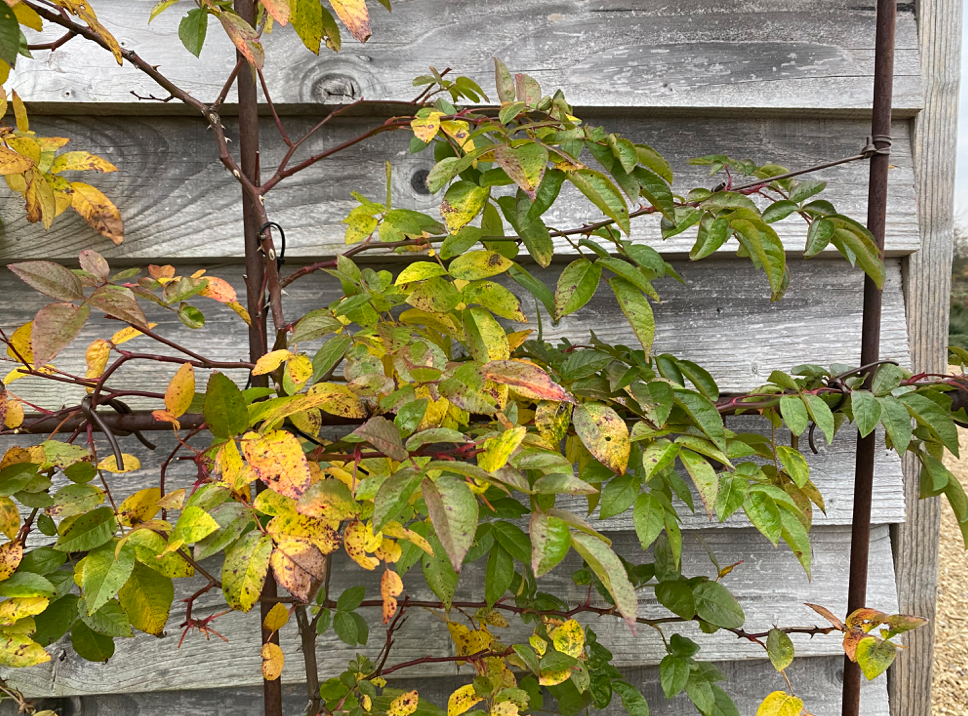
Beginning to train rosa ‘Bobby James’ laterally onto a closed wall trellis.

A clematis wall support brightens a narrow wall.

Spacer brackets are supplied for fixing the trellis to the wall.
